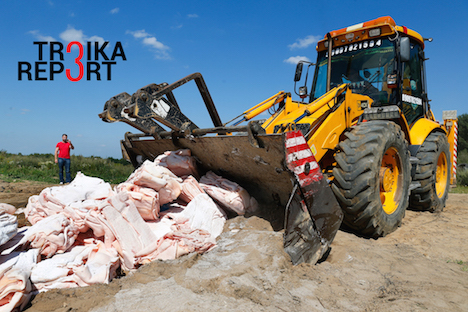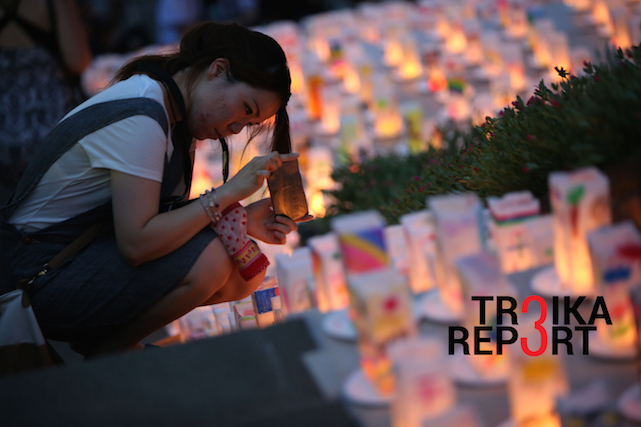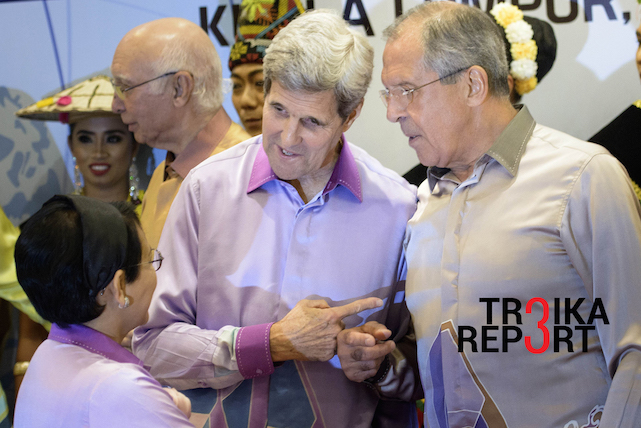

A bulldozer destroys illegally imported lard at an industrial facility in the Kaliningrad Region, Russia, Aug. 11, 2015. Source: Vitaly Nevar / TASS
Russia’s standoff with the West took another twist last week when a controversial move by the government to crack down on illegal food imports awoke heated debate in Russian society. The destruction by bulldozer of more than 300 tons of illegally imported Western food by Russian authorities last week raised eyebrows and even indignation, while experts queried by Troika Report also see a political message in this act of defiance amid the war of sanctions.
Moscow’s motives seem to be manifold. The products condemned to being burned, crushed or buried apparently arrived with documents describing them as concrete mixture or chewing gum, in what clearly amounts to a smuggling operation. The legality of these imports is dubious at least.
Russian President Vladimir Putin’s spokesperson Dmitry Peskov defined the destroyed food products as “pure contraband without any kind of certification whatsoever.”
“No one will take the responsibility to guarantee that the food, which may even look appetizing, is not dangerous for a person's health,” he said.
In accordance with the ruling of Rosselkhoznadzor, the state agricultural watchdog, the smuggled products will be either burned or buried, while meat is to be processed into fodder for livestock. However, the decision to dispose of uncertified imports was considered by many citizens as controversial if not sacrilegious, given that food in Russia has an added value due to the legacy of the “lean years” of the late Soviet period, let alone events such as the Siege of Leningrad.
The contentious character of this act and the symbolism of food destruction were not missed by the expert community. A known critic of the Kremlin, Alexander Goltz, who is deputy editor-in-chief of the opposition publication Yezhednevny Zhurnal’s website, had this to say to Troika Report:
“There is no doubt for me that this is some kind of symbolic act. To be honest, the Russian authorities are testing our nation: How far they can go? Recently, they initiated a public vote on the restoration of the monument to Felix Dzerzhinsky, the founder of the Soviet secret service, one of the bloodiest secret services in the world, in my view.
“Here comes the symbolic act of burning food. Our nation was starving several times in the last century. My generation can remember the lack and shortages of very simple food such as butter, meat, bread, and everything. Destruction of food in these circumstances shows that Russian authorities are testing our nation on its tolerance, its readiness to accept everything it is being proposed.”
— Does this “symbolic act,” as you say, have not only a domestic but an international audience?
“I agree one hundred percent. Another side of the story is to show to the West that the Russian people are ready to sacrifice everything for the status of a great power.”
True enough, foreign policy driven by national interest manifests itself in various forms, often with theatrical gestures. Symbolism is part of the art of diplomacy. The delicate balance of political and moral aspects of the issue in Russia has been explained to Troika Report by Maxim Suchkov, an expert with the Russian International Affairs Council:
“There are several facets to the problem. From a legal standpoint, banned goods should be considered as contraband, As such, their delivery to the needy would be illegal and not safe. Politically, this is a strong message to Russia’s foreign suppliers. Now that the food has been destroyed under the cameras and the issue is being debated by the public, it demonstrates that the stakes have increased and the government is serious about its commitment to counter-sanctions.
“However, the PR side of the problem, in my opinion, has not been well thought out and articulated. In a country which has survived through hunger, seeing a massive amount of food being destroyed, the ethical aspects prevail over the political objectives. I think it should have been calculated better.”
Even if the contentious decision had been packaged in a more convincing and appealing PR coating, it would still leave questions on the practicability of food destruction. One Russian parliamentarian suggested it would be more morally acceptable and practical to send the food with false documents, after checking its expiry dates, to the people in the Donbass region of eastern Ukraine as humanitarian aid.
Anyway, the signal sent by Moscow to the West cannot be dismissed: Despite the sanctions, Russia is in no mood to backtrack and bow to outside pressure.

Paper lanterns are placed for the victims on the eve of the 70th anniversary of the Nagasaki atomic bombing at the Peace Park in Nagasaki, southern Japan, on Saturday, Aug. 8, 2015. On two days in August 1945, U.S. planes dropped two atomic bombs on Japanese cities, one on Hiroshima, one on Nagasaki, the first and only time nuclear weapons have been used. Source: AP Photo/Eugene Hoshiko
Last week’s solemn commemoration of the destruction of the Japanese cities of Hiroshima and Nagasaki by atomic bombs dropped by the U.S. in August 1945 once again raised to a global level the issue of whether humanity is mature enough to destroy weapons of mass destruction and create a nuclear free world.
The horrifying consequences of the only case of nuclear bombing are appalling: The two bombs, nicknamed “Little Boy” and “Fat Man,” instantaneously wiped out more than 210,000 people, while thousands more were to suffer from radiation-related diseases caused by the “black rain” of radioactive particles which followed.
What are the lessons of Hiroshima and Nagasaki as viewed from Moscow? Dmitry Streltsov, Head of Department of Afro-Asian Studies at MGIMO University, made this comment for Troika Report:
“There are several lessons to be learned from that catastrophe. First of all, there is the moral aspect. The U.S. president made the decision to drop the atom bomb on Hiroshima on the pretext of saving the lives of American soldiers prior to the invasion of Japan.”
“There were almost 200,000 victims of the bombing. Even the American military establishment after the WWII admitted this slaughter was not necessary. Among them was General Douglas MacArthur, the Supreme Commander in the Southwest Pacific Area back in 1945.
“Chairman of the wartime Joint Chiefs of Staff, Admiral William D. Leahy also conceded this mistake: ‘It is my opinion that the use of the barbarous weapon at Hiroshima and Nagasaki was of no material assistance in our war against Japan. The Japanese were already defeated and ready to surrender...’By atom bombing Japan the United States subscribed to the moral norms of Genghis Khan.”
— Japan has called on world powers to abandon nuclear weapons totally. Is this viable today? What are the chances of creating of a non-violent and nuclear free world given that effort to sustain non-proliferation have been not fully successful?
“Japan has a foot in two camps. On the one hand, Japan is the only victim of atomic bombing and has the moral right to claim leadership of the movement for a non-nuclear world. On the other hand, Japan relies on the so-called ‘nuclear umbrella’of the United States, which is written into its military doctrine. This is sort of an ambiguous position. As for NGOs and public organizations promoting the concept of a nuclear free world, they have the moral right to do it.”
The atomic bombing which took place 70 years ago was described by the mayor of Hiroshima as “the absolute evil and ultimate inhumanity,” but the lessons of this atrocity, unfortunately, were not learned in order to make the world a safer place to live in.
Balancing on the brink of nuclear annihilation during the Cold War produced a sobering, albeit limited effect. The Non-Proliferation Treaty, signed in 1968, demanded that the five nuclear powers conduct disarmament negotiations while other nations committed themselves not to acquire nuclear bombs. Attempts to curb the spread and build-up of nuclear arsenals followed.
Despite some progress in cutting the number of nuclear warheads and delivery vehicles, the overall result was disappointing. India, Pakistan, Israel, and North Korea all developed nuclear weapons without permission, in doing so violating the letter and spirit of the Non-Proliferation Treaty. Moreover, the 1996 Comprehensive Nuclear-Test-Ban Treaty failed to acquire a legally binding force.
In a passionate but strictly rational article in The Irish Examiner, former director general of the International Atomic Energy Agency Hans Blix made a sound point: “It has been said that Hiroshima and Nagasaki created a taboo against any further use of nuclear weapons,” he said “Let us hope so, but let us also demand that the taboo be made legally binding.”
For now, the human race has to live side by side with almost 20,000 nuclear weapons with enough destructive power to obliterate it several times over. Public awareness of this insecure environment is good but not good enough. Neither are the legal frameworks that supposedly prevent the use of weapons of mass destruction. The only way is the development of a comprehensive system of conflict resolution to eliminate the slightest casus belli and bring nations to live not by the sword but by the law. But that may just be wishful thinking.

Indonesia’s Foreign Minister Retno L.P. Marsudi (left), U.S. Secretary of State John Kerry (center) and Russia's Foreign Minister Sergei Lavrov speak before the ASEAN Gala in Kuala Lumpur on Wednesday Aug. 5, 2015. Source: AP
With the Association of Southeast Asian Nations, or ASEAN, steadily evolving into the fourth-largest market after the EU, U.S. and China by 2030, Moscow is attempting to put its act together and position itself as one of the top trade partners and target for investments. This could expand the China-U.S.-ASEAN trio into a quartet if Russia joins in, but it would mean a long and uphill battle.
The charm offensive undertaken by Russian Foreign Minister Sergei Lavrov at the 48th ASEAN Foreign Ministers’ Meeting (AMM) held in Kuala Lumpur from Aug. 1-6 was testimony on its own that Moscow is determined to reap all possible benefits from the new long-term strategy of a “pivot to Asia” it has adopted in the face of the sanctions imposed on Moscow by the West over Russia’s role in the Ukrainian conflict.
Until recently, the ASEAN did not feature prominently in the upper half of the Russian priority list of trade and economic partners. Turnover has reached a modest level of $21 billion, although it is gaining momentum: A few years ago the figure was twice as low. Still, Russia is already among the ASEAN’s top 10 trading partners.
Later in August, a special joint committee on economic, scientific and technical cooperation is expected to be set up, while concurrently a delegation of Russian entrepreneurs representing 20 companies will engage in talks with their counterparts in Malaysia and Brunei on potential interaction in fields such as oil exploration and production, agricultural business, IT technologies, and transportation.
At the moment, the Asia-Pacific Region is witnessing the development of a rivalry with strong geopolitical overtones between China and the U.S. Washington has urged Beijing, which is involved in territorial disputes in the South China Sea, to introduce a moratorium on any activities on all of the islands that are a bone of contention between China, Japan, Vietnam, Malaysia, Taiwan, Brunei and the Philippines. Beijing has defied this demand, stating that players from outside the region have no right to meddle in the internal affairs of Asian nations.
Moscow is well aware of the investment potential of the steadily growing economies of the ASEAN, and would like to capitalize on its geographical proximity by inviting local entrepreneurs to make commitments to the various projects in the Russian Far East. The offer to make use of the Vladivostok free port zone as a transcontinental hub is the cherry on top.
The new vistas of cooperation, as viewed from Moscow, cannot but be appealing. The free trade zone agreement signed in May between the Eurasian Economic Community (EEU) and Vietnam is being presented as a sample of a productive model of interaction between the two regional alliances. As Lavrov emphasized, “we’re ready to make it a pilot project for a general liberalization (of trade and investment) between the EEU and ASEAN.”
Gleb Ivashentsov, a former ambassador and now member of the Russian International Affairs Council, has been named one of the “council of the wise”formed to promote Russia-ASEAN dialogue. Some say Russia has been lagging behind other major nations and it has missed many opportunities in Southeast Asia, with the ASEAN being the arena of competition between China and the U.S. Talking to Troika Report, Ivashentsov dismissed this assumption:
“Asia has a polycentric configuration. We should talk not only about China, the United States and the ASEAN, but also about Russia and Japan. It is much bigger than a triangle.”
“I think Russia will play a significant role in Southeast Asia.”
“There is a memory in Southeast Asia of Russia supporting national liberation movements in Vietnam, in Indonesia, and some other countries.”
“The rise of Russia as a new modern state will bring new possibilities for economic, scientific technological and energy cooperation with Southeast Asia.”
However, this upbeat assessment is disputed by Dmitry Mosyakov, an expert in regional affairs and deputy director of the Institute of Oriental Studies at the Russian Academy of Sciences. Mosyakov rules out the chances of the existing China-ASEAN-U.S. triangle being transformed by the addition of Russia:
“Russia has not taken sides in the territorial disputes in the South China Sea. Moscow distances itself from this controversy for fear of alienating its partners, be it Vietnam or China. On top of this, Moscow is used to developing substantial cooperation not with ASEAN as an alliance but with separate countries on a bilateral basis.”
In this case, would any other country, apart from Vietnam, care to establish privileged relations with the Eurasian Economic Union? Gleb Ivashentsov believes this is possible, placing the emphasis not only on the provision of energy or sales of military hardware, but on the flow of capital and joint production.
Despite the evident fact that Russia is also a Pacific Rim country, the underdeveloped regions of Siberia and the Russian Far East do not have much to offer those seeking an immediate return on capital and a high rate of return in general. Like it or not, Russia is a relevant newcomer to the ASEAN and Asia-Pacific Region markets, where it has to compete with not one, but two formidable trade superpowers.
The opinion of the writers may not necessarily reflect the position of RBTH or its staff.
All rights reserved by Rossiyskaya Gazeta.
Subscribe
to our newsletter!
Get the week's best stories straight to your inbox